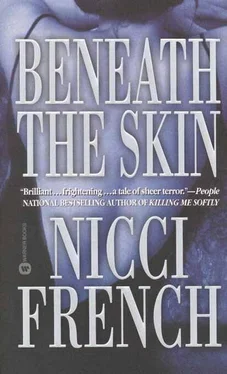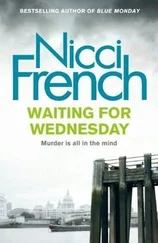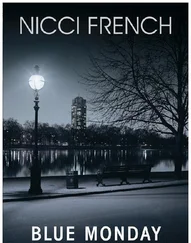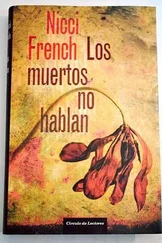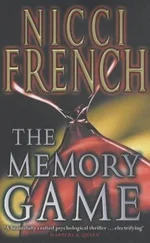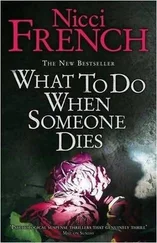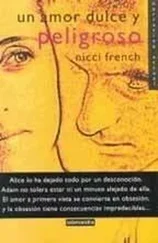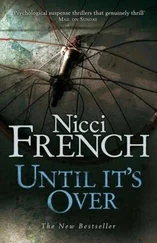I had felt that Zoe was much younger than me; Jennifer Hintlesham seemed a generation older. It wasn’t that she had an older-looking face than me. The only faces that look more haggard than mine, especially first thing in the morning, have been dug out of a peat bog after two thousand years of mummification. She just seemed grown-up. I felt I’d like to have met Zoe. I wasn’t sure I’d have been Jennifer’s type. I looked at the file again. Husband and three children, names and ages. Fuck. I wrote down details.
Something occurred to me. I looked in the pile of files where these two had come from. As I thought, there was a file with my name on it. I opened it and was looking at a picture of myself. Nadia Elizabeth Blake, b. 1971. I shivered. Maybe in a few weeks this file would be fatter and another would have been opened.
I looked at my watch. What on earth next? And what was the point of this, apart from curiosity? When I was eleven years old there was a five-meter board at our local swimming pool. I never dared jump from it until one day I just climbed the steps as if I happened to be climbing a ladder for no reason and stepped over the edge of the board without thinking and I’d done it. I did this now.
I reached down for the first album of pictures, bound in gaudy red plastic. It should have contained pictures of little girls blowing out candles and people kicking balls along the beach. I opened it and mechanically turned the pages one after another. Not that much to see, really. I turned back to the beginning to check. Yes, this was the scene of the murder of Zoe Haratounian. Her own flat. And then there she was. She was lying facedown on a carpet. She wasn’t naked or anything like that. She was wearing knickers and a T-shirt. And she didn’t look dead. She could have been asleep. There was a ribbon or tie or something pulled tight around her neck and there were photographs showing it from various angles. I just kept looking at the knickers and the shirt. It was the thought of her putting on those clothes that morning and not knowing that she’d never take them off. It’s the sort of stupid thought you can’t get out of your mind.
I put it down and picked up the second book. The crime scene at Jennifer Hintlesham’s house. I began to flick dutifully through it as I had the previous one, but then I stopped. This looked completely different. It was a single photograph, it was a single scene, but I saw it in fragments: staring open eyes, wire around the neck, clothes ripped or slashed off, legs splayed, and something like a metal bar pushed into her, I couldn’t see into what bit of her. I threw the book down and ran to the sink. I got there just in time, vomit spluttering out of my mouth. My stomach heaved and heaved, painfully emptying itself. I looked down and it was almost funny. The sink was full of dirty dishes. Even dirtier dishes.
I washed my face in warm and cold water and then embarked on the most disgusting washing-up of my life, and I’m speaking as someone who shared a house with a girl and two boys at college. The activity made me feel steadier. I was able to walk back to the table and close the photograph album without looking at it.
I didn’t have much time. I would have to be selective. I rummaged through the files quickly, checking their contents. I saw plans of Zoe’s flat and Jennifer’s house. I skimmed through witnesses’ statements. They were so long, rambling, and diffuse that it was almost impossible to extract any sense from them. Zoe’s boyfriend, Fred, talked about the increasing fear she had felt and his efforts to calm her. Her friend, Louise, seemed distraught. She had been the one who had actually been sitting outside the flat in her car while Zoe had been strangled. The witness statements for Jennifer’s murder filled ten bulky files. I could do little more than identify the interviewees, mainly people who worked for her. The Hintleshams seemed to have been major employers.
I paid a little more attention to the pathologist’s reports on the two dead women. Zoe’s was much simpler: ligature strangulation with the belt of her dressing gown. There were some minor contusions, but these were only related to the force required to hold her down while she was strangled. Vaginal and anal swabs showed no sign of sexual assault.
The report on Jennifer’s death was far longer. I did nothing more than note details: ligature strangulation, a thin deep furrow on the neck consistent with the use of wire; incised wounds and stabbed wounds; blood splashes, pools, smears, trails; tearing of the perineum; a copious amount of urine. She’d pissed herself.
There was a fat file dealing with the analysis of the letters. They included photocopies of the letters sent to Zoe and Jennifer, and I read them with a macabre guilty sense that I was reading stolen love letters. But they were love letters, with their promises and their vows. And there was a drawing as well of a mutilated Zoe. Strangely, of all the horrors I saw that day, it was that vile, crude drawing that made me cry. It was the one that made me dwell on the crazed ingenuity that one person was putting into destroying another. I skimmed through the analysis of the documents. There had been attempts to associate the letters with people Zoe knew: her boyfriend, Fred; an ex-boyfriend; a real estate agent; a potential buyer of her flat. However, incised marks on the drawing (confirmed, a note added, by injuries inflicted on Jennifer Hintlesham) showed conclusively that the murderer was left-handed. The above suspects were all right-handed.
There were files of crime-scene reports on dust and fabric and hair and much else. Many of them were so technical that I couldn’t work out whether anything significant had been found. It didn’t look like it. There was a single-page summary report at the front, which was copied to Links, Cameron, and other members of the murder inquiry. What was clearly stated was that no significant links had been found among the forensic traces recovered from the two murder scenes. The hair and fiber samples found on the clothes that the dead Zoe was wearing, and also found on the carpet, bedclothes, and other items of clothing, were only those of the recent inhabitants of the flat: namely her boyfriend, Fred, and Zoe herself. The hair and fiber analysis of the Jennifer Hintlesham crime scene was more complicated. There were numerous unidentified samples due to the sheer number of people who had been on the premises. There was, however, no forensic link between the two scenes, apart from Jenny’s locket found in Zoe’s flat, and Zoe’s photograph found in Jenny’s house. More awful news.
I also read through a bundle of internal memos, which outlined the various stages of the inquiry, including the result of an informal internal inquiry that was marked “Most Secret.” It was there I learned that Jennifer Hintlesham’s guard had been removed because her husband, Clive, was in the process of being charged with the murder of Zoe Haratounian. What a fuck-up.
Just as I was about to call Cameron back I started flicking through a routine-looking file. It consisted of rosters, minutes of meetings, holiday assignments. But then at the bottom a photocopied memo caught my eye. It was from Links to a Dr. Michael Griffen, with copies to Stadler, Grace Schilling, Lynne, and a dozen other names I didn’t recognize. It began by apparently responding to a complaint by Dr. Griffen that the two murder scenes, especially in the flat of Zoe Haratounian, had been compromised by faulty procedures by the first officers on the scene:
I will make every effort to ensure that the scene of any future scene will be swiftly and effectively sealed. I realize that in all probability, and in no small part because of the practical difficulties of personal protection, the solution of this case will lie in the hands of the forensic scientists and we will furnish you with all possible cooperation.
Читать дальше
